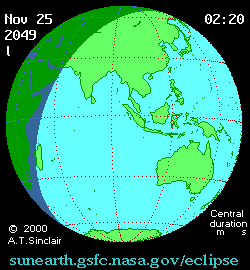| Hybrid eclipse | |
| Gamma | 0.2943 |
|---|---|
| Magnitude | 1.0057 |
| Maximum eclipse | |
| Duration | 38 s (0 min 38 s) |
| Coordinates | 3°48′S95°12′E / 3.8°S 95.2°E |
| Max. width of band | 21 km (13 mi) |
| Times (UTC) | |
| Greatest eclipse | 5:33:48 |
| References | |
| Saros | 143 (25 of 72) |
| Catalog # (SE5000) | 9618 |
A total solar eclipse will occur at the Moon's ascending node of orbit on Thursday, November 25, 2049, [1] with a magnitude of 1.0057. It is a hybrid event, with only a fraction of its path as total, and longer sections at the start and end as an annular eclipse. A solar eclipse occurs when the Moon passes between Earth and the Sun, thereby totally or partly obscuring the image of the Sun for a viewer on Earth. An annular solar eclipse occurs when the Moon's apparent diameter is smaller than the Sun's, blocking most of the Sun's light and causing the Sun to look like an annulus (ring). An annular eclipse appears as a partial eclipse over a region of the Earth thousands of kilometres wide. Occurring about 3.2 days before perigee (on November 28, 2049, at 11:05 UTC), the Moon's apparent diameter will be larger. [2]
Contents
- Images
- Eclipse timing
- Places experiencing partial eclipse
- Eclipse details
- Eclipse season
- Related eclipses
- Eclipses in 2049
- Metonic
- Tzolkinex
- Half-Saros
- Tritos
- Solar Saros 143
- Inex
- Triad
- Solar eclipses of 2047–2050
- Saros 143
- Metonic series
- Tritos series
- Inex series
- Notes
- References
The path of the eclipse will be visible as an annular eclipse from parts of Saudi Arabia and Yemen before transitioning to a total eclipse. Totality will be visible from parts of Indonesia before the eclipse transforms back to an annular eclipse, then passing over Micronesia. A partial solar eclipse will also be visible for parts of East Africa, the Middle East, Central Asia, South Asia, Southeast Asia, and Australia.






































































































